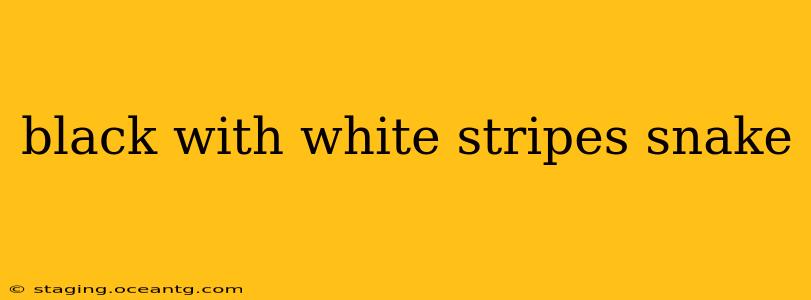Many snakes boast a black and white striped pattern, making identification crucial for safety. This guide will explore several species exhibiting this coloration, highlight key differentiating features, and offer advice on how to react if you encounter one. Remember, always prioritize safety and avoid handling any wild snake.
What Kind of Snake is Black with White Stripes?
Several snake species exhibit a black and white striped pattern, varying in intensity and arrangement. Pinpointing the exact species requires careful observation and consideration of geographical location. Some common possibilities include:
-
Eastern Hognose Snake (Heterodon platirhinos): These snakes are known for their upturned snout and often display a pattern of irregular black and white blotches or stripes, particularly in younger individuals. Adult coloration can be highly variable.
-
Western Hognose Snake (Heterodon nasicus): Similar to the Eastern Hognose, but with subtle differences in scale patterns and geographic range.
-
Garter Snakes (Thamnophis sirtalis): Certain subspecies of garter snakes, like the common garter snake, can display black and white stripes, although they often have additional colors involved as well. Their stripes tend to be more longitudinal and consistent.
-
Ring-necked Snakes (Diadophis punctatus): While typically known for their distinctive ring around their neck, some variations can display darker coloration with white stripes or markings.
-
Other regional species: Many other regional snake species may possess variations in their coloration that include black and white stripes. Accurate identification requires careful consideration of geographic location and detailed observation of the snake's characteristics.
How Can I Identify a Black and White Striped Snake?
Accurate identification hinges on several key factors beyond just color:
-
Geographic location: Where was the snake sighted? This significantly narrows down the possibilities.
-
Size and body shape: Note the snake's overall length, thickness, and the shape of its head (e.g., upturned, rounded, triangular).
-
Scale patterns: Examine the arrangement of scales. Are they smooth or keeled? Are there distinct patterns beyond the stripes?
-
Head markings: Pay close attention to any unique markings on the head.
-
Pupil shape: Is the pupil round, elliptical, or vertical?
-
Photography: If safe to do so, take a clear photograph from a distance. This will assist in identification.
Is a Black and White Striped Snake Poisonous?
No, most black and white striped snakes are not venomous. The species listed above are all non-venomous. However, even non-venomous snakes can bite if threatened, so it’s crucial to avoid handling them.
What Should I Do If I See a Black and White Striped Snake?
-
Observe from a safe distance: Do not approach the snake. Appreciate it from afar.
-
Keep pets away: Prevent pets from approaching the snake.
-
Leave it alone: Snakes play a crucial role in the ecosystem.
-
Identify the snake (if possible and safe): Use your observations and resources to try to identify the species.
-
Contact a local wildlife authority if necessary: If you are concerned about the snake's presence near your home or if it poses an immediate danger, contact your local wildlife agency or animal control.
What are some common misconceptions about black and white striped snakes?
Many people associate black and white striped patterns with venomous snakes, due to the iconic image of the coral snake. However, the vast majority of snakes with this pattern are harmless. Don't assume a snake is venomous based solely on its color pattern. Always seek to correctly identify the species before making any assumptions about its venomousness.
How can I prevent snakes from entering my property?
Maintaining a tidy yard can be surprisingly effective. Remove brush piles, keep grass mowed, and seal any gaps or cracks in your home's foundation to deter snakes from seeking shelter.
This information is for educational purposes only. Always consult with a herpetologist or other wildlife expert for accurate identification and safety advice. Never attempt to handle a wild snake without proper training and equipment.
